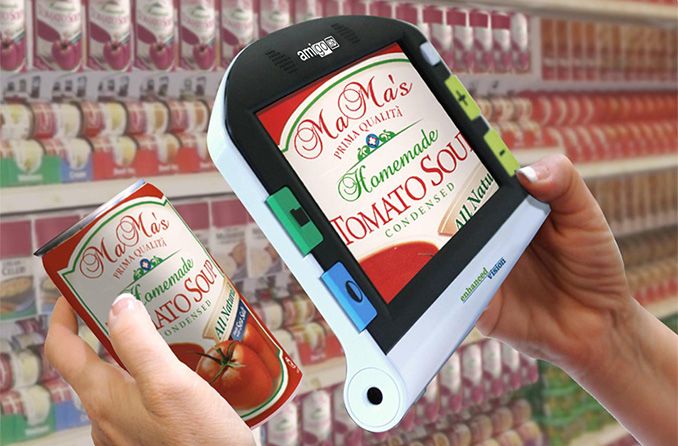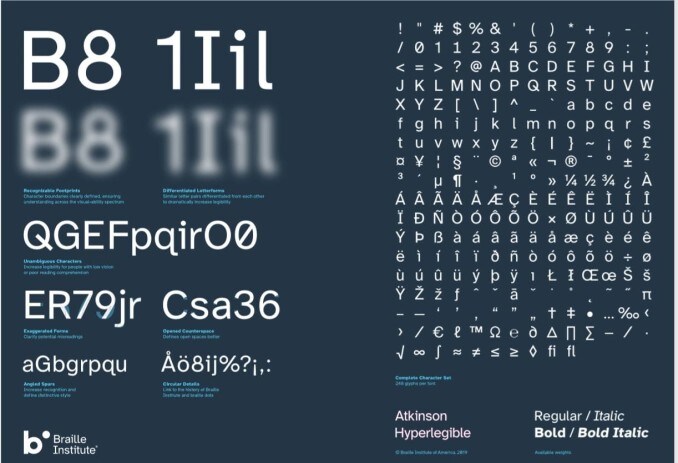All about magnifying glasses
There are magnifying glasses and eyeglasses available today that can aid with almost any visual need imaginable. Some are simple, like reading glasses or old-fashioned handheld magnifying glasses.
However, today’s technology has taken us far beyond these basic methods of magnification, providing eyewear that can significantly improve quality of life for the visually impaired. These breakthrough innovations include optoelectronic systems and Essilor’s newly developed augmented reality glasses.
How do you know what magnification strength is best in magnifying glasses?
Magnification power is indicated by a number and the letter “X,” which simply stands for “times.” If a magnifying glass has a power of 2X, then the glass will magnify an object or printed type to twice its actual size. A magnifying glass for general use will have a power of 2X or 3X.
One technical term you may run into when choosing magnifying glasses is “diopter,” which refers to the degree of lens curvature. As curvature increases, so does the magnification and thickness of the lens.
If given the diopter number, you can figure out the power of the lens. To calculate it, you divide the diopter number by four and then add one. For instance, if the diopter number is 8, the power of the lens will be 3X.
Magnifying glasses for the visually impaired
Low vision is a term used to describe several types of visual problems that impair one’s ability to do everyday activities like driving, reading, writing, distinguishing colors, seeing clear images on TV or computer screens or even recognizing faces.
Low vision is not the same as presbyopia, which is helped by simple magnification. Low vision involves significant visual deterioration. It is permanent and can’t be cured with standard medical treatments or with glasses or contact lenses. But there are aids, including using magnification and more advanced technology, that can help with everyday activities and prevent low vision from getting worse.
Older adults are more prone to suffering from low vision because of their susceptibility to the conditions that cause it. People at any age who suffer brain injuries may also have problems with low vision. A professional eye exam will detect if this problem exists.
SEE RELATED: Low vision aids for reading
How magnifying glasses can help
The basic handheld magnifying glass can help a person with low vision read small text or numbers such as labels or credit card numbers. Adding lights to some magnifying glasses can also be very helpful. There are a variety of magnifying glasses with and without lights from which to choose.
Optical magnifying systems
Several magnifying optical devices create an enlarged version of what is being viewed. These include microscopic and telescopic systems and spectacle magnifiers. Although these are affordable, portable and easy to use, they may be suited only for specific tasks.
Microscopic magnifying systems are spectacles with the magnifiers mounted directly onto the glasses. Their use is limited to very close viewing.
Telescopic systems help people with low vision view at very far distances. The two types of telescopic systems are Galileo and Kepler. The Galileo is the most adaptable and can be used for things like watching TV at an intermediate distance. The Kepler is best for seeing at a distance while moving, which can help with important tasks like reading street signs.
Another device used for far-distance viewing is a monocular magnifying glass. This is like half of a pair of binoculars with an eyecup that is flexible and allows for comfortable use with eyeglasses. The magnification on these devices can be adjusted from 4X to 8X.
Electronic magnifying systems
These electronic systems are like video magnifiers. They are not as portable as other systems but are still popular with the visually impaired because they offer much higher magnification than other devices. They also come with a range of contrast and amplification settings.
Augmented reality magnifying glasses
Essilor’s Research & Development team is currently creating and refining magnifying glasses that work by filming what the wearer is looking at and then projecting that image onto the retina of their right eye. The person wearing these glasses can use a control to magnify the image, change contrast or brightness and even zoom in.
Handheld magnifying glasses
Handheld magnifiers are the simplest tool we can use to help with visual tasks such as reading or hobbies such as puzzles, sewing or drawing. We could all use some form of visual magnification at one time or another.
Choosing the best strength and type of magnifying glass depends on its intended use. A hobbyist may need a simple magnifying glass, while professional jewelers who examine diamonds and other gems will need a version that’s more precise and powerful, maybe with added illumination.
As the power of a lens increases, its size decreases. Very high-powered magnifiers are made for those needing loupes, which are not handheld but attached to clear-lens eyeglasses.
Lens powers of 5X to 6X provide high magnification as well as a workable field of vision. When given a choice between lenses with equal power and quality, it’s best to go for the larger one, as long as it’s lightweight enough to use conveniently.
Fancii Optics, which guarantees the quality of all its magnifying glasses, warns about “cheap, inferior” versions that advertise as much as 45X magnification. It says these claims are false because anything over 20X would have to be so small in size that it would be considered a loupe magnifier. High-quality lenses with high magnification are more costly because they are harder to produce.
To correctly use a handheld magnifier, hold the lens close to your eyes and move the object close to the glass. The idea is to use the magnifying glass in the same way that you would look through your eyeglasses while moving the object until it is in focus. If you wear prescription eyeglasses, you would not remove these while using the magnifying glass.
Magnifying reading glasses
Reading glasses, or wearable magnifying glasses, are probably the most commonly used eyeglasses. They are ideal for those having trouble reading small print, who have equal vision in both eyes and have never needed an eyeglass prescription for near- or far-sightedness or astigmatism.
Reading glasses can help because they simply magnify the text on a page. They are also very affordable, accessible and easy to use. The lenses are nonprescription, double and duplicate magnifying glasses set in frames.
Reading glasses are often the aid of choice for those who have developed a normal age-related condition known as presbyopia, which diminishes one’s ability to focus on anything close.
Presbyopia develops as the eye lens thickens and becomes less flexible, beginning around age 40. Also, muscle fibers supporting the lens lose elasticity as we age, adding to difficulty focusing.
Presbyopia can happen even with those who are nearsighted — those who usually see near objects well and use prescription glasses to help them see objects at a distance.
Magnifying reading glasses come in powers indicated by a diopter (D) number, preceded by a plus sign. Power commonly ranges from +0.75 to +3.00. Because presbyopia progresses with age, those in their 40s will often start with a lower diopter number that will likely later increase.
The power you choose may also depend on the intended use. For example, a book is usually closer to your eyes than a computer screen. Therefore, you’d choose a lower number for viewing screens than you would for reading printed material.
You may want to buy two or more different powers to accommodate different uses, but it’s advised to buy magnifications beyond what you need.
The fact that these glasses simply magnify means they will not help those who need prescription lenses or have vision that is not the same in both eyes.
Another downside to using reading glasses is the inconvenience of looking back and forth from near to far. One solution is prescription glasses with progressive lenses , which give the wearer a smooth transition from near to far viewing and sharp focus at any distance.
Even if basic magnifying reading glasses are sufficient, experts warn that getting the wrong pair can cause headaches, eye strain and even nausea. “When it comes to your eyes,” says one user and seller, “you should not fool around.” This is why many eye care professionals recommend getting an eye exam before choosing a pair of reading glasses, even though these are sold without a prescription.
As a spokesperson for the American Academy of Ophthalmology, Dr. Michelle Andreoli suggests an easy way to test the quality and strength of any over-the-counter reading glasses you are considering. While shopping, find an item such as a greeting card and hold it at a comfortable distance. Then try different glasses until you find a pair that allows you to see the type on the card easily and clearly. If none pass the test, then consider getting an eye exam.
And, by the way, it is a myth that using reading glasses will weaken your eyes, according to Dr. Ming Wang of Wang Vision 3D Cataract & LASIK Center in Nashville. In fact, if you have presbyopia, it’s trying to focus without them that puts a strain on your eyes and weakens the muscles around the eye lenses.
Magnifying glasses for hobbyists and seamstresses
You’ll find many magnifying glass choices to help with hobbies and sports.
The least expensive and most portable option may be clip-on, flip-up magnifying glasses, which you can find online for less than $10. Fishermen who need help with fly-tying or baiting can get the flip-up kind that clip on to their caps, leaving both hands free. An added convenience is that these magnifying glasses can be worn over prescription glasses. They are also good for other near-vision tasks.
Those who do needlework like cross-stitch or embroidery often prefer lighted magnifying glasses on stands or wearable magnifying glasses that fit around the neck called chest-rest magnifying glasses. These free up both hands, which is necessary for this kind of work, and their 4-inch diameter provides the necessarily large field of vision. Also, some illuminated magnifying glasses are convertible to either around-the-neck or free-standing use.
It is advised for this kind of work or any task requiring even lighting to choose a device that has lights embedded around the perimeter of the magnifying lens. A magnification strength of 2X with at least a 4-inch opening should be sufficient.
Stamp and coin collectors and puzzlers will probably do well with a good-sized 10X handheld lighted version that is battery operated. Jewelry makers might prefer a standing lamp magnifying glass with 10X magnification strength or a similar table-top magnifying glass.
Magnifying glasses for professionals
Professionals such as dentists, surgeons and hygienists often use magnifiers known as loupe magnifying glasses. Loupes used by medical professionals are small, lightweight telescopes attached to eyeglasses.
Dental and surgical magnifying glasses require exceptional visual precision. These are usually used along with headlights and attachable shields that convert them into magnifying safety glasses.
These loupe devices can be purchased in varying strengths individually. At least one manufacturer offers an “Omniopic” option with interchangeable magnification loupes that allow clinicians to choose the optimal power, from 2.5X to 5.5X, based on the procedure.
Jewelers can easily find online affordable 10X to 20X magnifying glasses with LED lights for jewelry or watch repair. These come with either single or double lenses. Such lenses also come attached to headbands that allow them to be used while wearing prescription eyeglasses. Because they require far less precision and accuracy than magnifiers needed by surgeons or dentists, they are much more affordable than those that are used for medical procedures.
Choosing the best magnifying glasses for your individual needs
There are visual aid options to suit nearly every individual’s lifestyle.
If seeking a magnifier for everyday close-up work, one can usually feel confident choosing a magnifying glass on their own. However, lens centration and proper frame fitting matter for eye comfort and clarity when it comes to magnifying eyeglasses. Thus, it is recommended that you visit your eye doctor to get a comprehensive eye exam. Your doctor will determine the best option for your eyes and personal visual needs.











